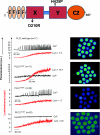Male infertility-linked point mutation disrupts the Ca2+ oscillation-inducing and PIP(2) hydrolysis activity of sperm PLCζ
- PMID: 21204786
- PMCID: PMC3195387
- DOI: 10.1042/BJ20101772
Male infertility-linked point mutation disrupts the Ca2+ oscillation-inducing and PIP(2) hydrolysis activity of sperm PLCζ
Erratum in
- Biochem J. 2011 May 1;435(3):791. Nounesis, Georg [corrected to Nounesis, George]
Abstract
A male infertility-linked human PLCζ (phospholipase Cζ) mutation introduced into mouse PLCζ completely abolishes both in vitro PIP(2) (phosphatidylinositol 4,5-bisphosphate) hydrolysis activity and the ability to trigger in vivo Ca2+ oscillations in mouse eggs. Wild-type PLCζ initiated a normal pattern of Ca2+ oscillations in eggs in the presence of 10-fold higher mutant PLCζ, suggesting that infertility is not mediated by a dominant-negative mechanism.
© The Authors Journal compilation © 2011 Biochemical Society
Figures




Similar articles
-
Essential Role of the EF-hand Domain in Targeting Sperm Phospholipase Cζ to Membrane Phosphatidylinositol 4,5-Bisphosphate (PIP2).J Biol Chem. 2015 Dec 4;290(49):29519-30. doi: 10.1074/jbc.M115.658443. Epub 2015 Oct 1. J Biol Chem. 2015. PMID: 26429913 Free PMC article.
-
Male infertility-linked point mutation reveals a vital binding role for the C2 domain of sperm PLCζ.Biochem J. 2017 Mar 7;474(6):1003-1016. doi: 10.1042/BCJ20161057. Biochem J. 2017. PMID: 28270562
-
A Novel PLCζ Mutation Linked to Male Factor Infertility Induces a Gain-of-Function Effect on Ca2+ Oscillations in Eggs.Int J Mol Sci. 2025 Jun 28;26(13):6241. doi: 10.3390/ijms26136241. Int J Mol Sci. 2025. PMID: 40650019 Free PMC article.
-
Novel signalling mechanism and clinical applications of sperm-specific PLCζ.Biochem Soc Trans. 2015 Jun;43(3):371-6. doi: 10.1042/BST20140291. Biochem Soc Trans. 2015. PMID: 26009178 Review.
-
Phospholipase C zeta and calcium oscillations at fertilisation: The evidence, applications, and further questions.Adv Biol Regul. 2018 Jan;67:148-162. doi: 10.1016/j.jbior.2017.10.012. Epub 2017 Oct 27. Adv Biol Regul. 2018. PMID: 29108881 Review.
Cited by
-
PLCζ sequence, protein levels, and distribution in human sperm do not correlate with semen characteristics and fertilization rates after ICSI.J Assist Reprod Genet. 2016 Jun;33(6):747-56. doi: 10.1007/s10815-016-0718-0. Epub 2016 May 2. J Assist Reprod Genet. 2016. PMID: 27138933 Free PMC article.
-
Phospholipase Cζ rescues failed oocyte activation in a prototype of male factor infertility.Fertil Steril. 2013 Jan;99(1):76-85. doi: 10.1016/j.fertnstert.2012.08.035. Epub 2012 Sep 21. Fertil Steril. 2013. PMID: 22999959 Free PMC article.
-
SPERM FACTORS AND EGG ACTIVATION: Phospholipase C zeta (PLCZ1) and the clinical diagnosis of oocyte activation deficiency.Reproduction. 2022 May 23;164(1):F53-F66. doi: 10.1530/REP-21-0458. Reproduction. 2022. PMID: 35312629 Free PMC article. Review.
-
Loss of activity mutations in phospholipase C zeta (PLCζ) abolishes calcium oscillatory ability of human recombinant protein in mouse oocytes.Hum Reprod. 2011 Dec;26(12):3372-87. doi: 10.1093/humrep/der336. Epub 2011 Oct 18. Hum Reprod. 2011. PMID: 22010140 Free PMC article.
-
Modulators of calcium signalling at fertilization.Open Biol. 2020 Jul;10(7):200118. doi: 10.1098/rsob.200118. Epub 2020 Jul 15. Open Biol. 2020. PMID: 32673518 Free PMC article. Review.
References
-
- Stricker S. A. Comparative biology of calcium signaling during fertilization and egg activation in animals. Dev. Biol. 1999;211:157–176. - PubMed
-
- Runft L. L., Jaffe L. A., Mehlmann L. M. Egg activation at fertilization: where it all begins. Dev. Biol. 2002;245:237–254. - PubMed
-
- Swann K. A cytosolic sperm factor stimulates repetitive calcium increases and mimics fertilization in hamster eggs. Development. 1990;110:1295–1302. - PubMed
-
- Schultz R. M., Kopf G. S. Molecular basis of mammalian egg activation. Curr. Top. Dev. Biol. 1995;30:21–62. - PubMed
-
- Jones K. T. Ca2+ oscillations in the activation of the egg and development of the embryo in mammals. Int. J. Dev. Biol. 1998;42:1–10. - PubMed
Publication types
MeSH terms
Substances
Grants and funding
LinkOut - more resources
Full Text Sources
Medical
Miscellaneous

